1971 North Indian Ocean cyclone season
The 1971 North Indian Ocean cyclone season was part of the annual cycle of tropical cyclone formation. The season has no official bounds but cyclones tend to form between April and December. These dates conventionally delimit the period of each year when most tropical cyclones form in the northern Indian Ocean. There are two main seas in the North Indian Ocean—the Bay of Bengal to the east of the Indian subcontinent and the Arabian Sea to the west of India. The official Regional Specialized Meteorological Centre in this basin is the India Meteorological Department (IMD), while the Joint Typhoon Warning Center (JTWC) releases unofficial advisories. An average of five tropical cyclones form in the North Indian Ocean every season with peaks in May and November.[1] Cyclones occurring between the meridians 45°E and 100°E are included in the season by the IMD.[2]
| 1971 North Indian Ocean cyclone season | |
|---|---|
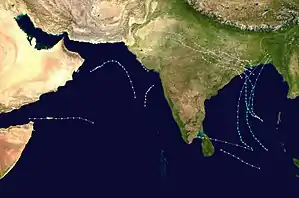 Season summary map | |
| Seasonal boundaries | |
| First system formed | Unknown |
| Last system dissipated | Unknown |
| Seasonal statistics | |
| Deep depressions | 15 |
| Cyclonic storms | 7 |
| Severe cyclonic storms | 6 |
| Total fatalities | Unknown |
| Total damage | Unknown |
| Related articles | |
Seasonal summary
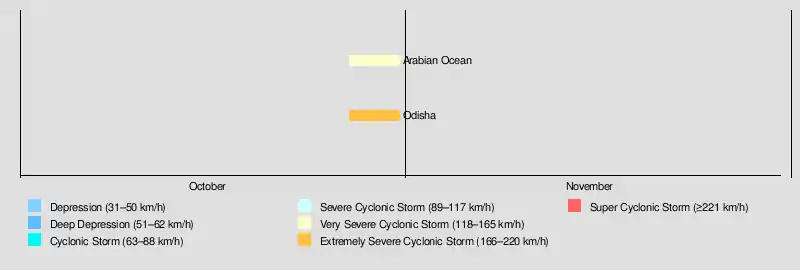
Systems
1971 Pre-September Bay of Bengal cyclone
This cyclone was formed on 7 September and made landfall at the coast of Odisha on 10 September. Its remnants were tracked as far as Haryana due to the monsoonal flow and dissipated on 14 September. Due to the storm, 90 people and 8,000 cattle perished. There were many damages to agricultural crops, telecommunications and other property in Odisha's coastal districts.
1971 Mid-September Bay of Bengal cyclone
This cyclone was formed on 20 September and made landfall at the same place in Odisha on 22 September,which were already affected by another cyclone which attacked the same place 12 days before and dissipated on 25 September. There were considerable damages crops and houses in Odisha and Andhra Pradesh.
1971 Late-September Bay of Bengal cyclone
This cyclone was formed on 27 September and made landfall at West Bengal in the Sunderbans and dissipated on 1 October. 60 people were died due to the storm and thousands of houses were damaged due to gust winds.
1971 October Arabian Ocean cyclone
| Severe cyclonic storm (IMD) | |
| Category 1 tropical cyclone (SSHWS) | |
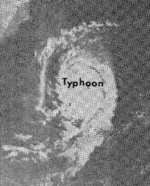 | |
| Duration | October 27 – October 31 |
|---|---|
| Peak intensity | 110 km/h (70 mph) (3-min) |
A tropical cyclone moved through the Arabian Sea near the end of October.
1971 Odisha cyclone
| Extremely severe cyclonic storm (IMD) | |
| Category 3 tropical cyclone (SSHWS) | |
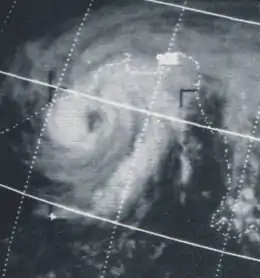 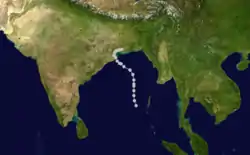 | |
| Duration | October 27 – October 31 |
|---|---|
| Peak intensity | 165 km/h (105 mph) (3-min) 966 hPa (mbar) |
On October 27 a tropical depression formed in the Bay of Bengal. It tracked northward, rapidly strengthened until reached a peak of 115 mph winds. The cyclone struck Paradip in Odisha, India, on October 29, and dissipated by the same day. The storm surge and flooding from the system caused 10,800 fatalities.[3]
See also
- List of North Indian Ocean cyclone seasons
- 1971 Atlantic hurricane season
- 1971 Pacific hurricane season
- 1971 Pacific typhoon season
- Australian cyclone seasons: 1970–71, 1971–72
- South Pacific cyclone seasons: 1970–71, 1971–72
- South-West Indian Ocean cyclone seasons: 1970–71, 1971–72
References
- "Frequently Asked Questions: What is the annual frequency of Cyclones over the Indian Seas? What is its intra-annual variation?". Indian Meteorological Department. 2012. Archived from the original on May 21, 2015. Retrieved June 8, 2012.
- "Bulletins Issued by Regional Specialized Meteorological Centre (RSMC) - Tropical Cyclones, New Delhi" (PDF). India Meteorological Department. May 25, 2009. Archived from the original (PDF) on 2012-04-12. Retrieved July 16, 2012.
- "Natural catastrophes and man-made disasters in 2008: North America and Asia suffer heavy losses" (PDF). Swiss Reinsurance Company Ltd. 21 January 2009. p. 38. Retrieved 23 May 2017.